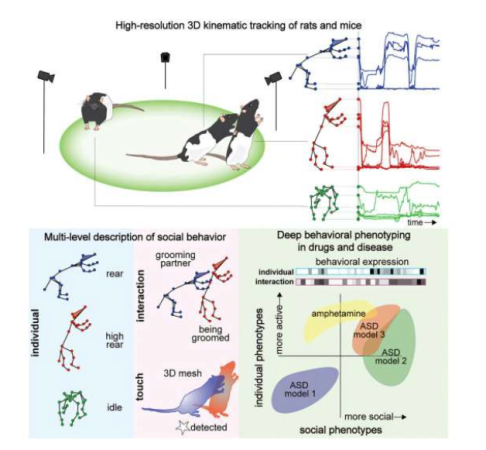Biomedical engineers at Duke University have devised a 3D imaging technique that precisely maps and categorizes animal social behaviors. By quantitatively tracking the movements, interactions, and physical contact between rodents, the researchers successfully revealed, for the first time, how various genetic models of autism influence social behavior in rats.
This innovative tool paves the way for investigating new types of neuropsychiatric disorders in laboratory animals. The study was published in the journal Cell.
Though neuroscience has a growing set of powerful tools for understanding brain function—such as high-resolution calcium imaging for monitoring neural firing and CRISPR techniques for manipulating neuronal activity—there has been a significant gap in technology for linking brain activity to actual behavior and movement.
“Despite behavior and movement being core outputs of the brain, tools to accurately and comprehensively measure those outputs have largely been an afterthought. Without precise behavioral quantification, it’s difficult to understand how disease or treatments affect those outputs,” said Timothy Dunn, assistant professor of biomedical engineering.
Historically, behavior tracking in animal models was done through manual observation or rudimentary imaging and computational methods that only tracked general position over time.
To overcome this limitation, Dunn and his team created DANNCE (3-Dimensional Aligned Neural Network for Computational Ethology) in 2021. Using video recordings of rats in motion, they trained machine-learning algorithms and neural networks to pinpoint the exact 3D positions of the rats' joints. This data could then be aligned with neural recordings to explore correlations between brain activity and specific behaviors.
Expanding on this earlier work, Dunn, graduate student Tianqing Li, and their colleagues have now developed social-DANNCE (s-DANNCE), a platform specifically designed to map social interactions between animals.
“Tracking social behavior is particularly challenging,” Dunn explained. “Computer vision struggles to distinguish and track individuals that are physically close or similar in appearance. Additionally, differentiating solitary from social behavior is difficult because many interactions are subtle.”
Using the foundation laid by DANNCE, the team recorded footage of two to three rats interacting freely in a designated recording space. The videos were then analyzed by a neural network trained to track individual animals' movements.
By converting this movement data into 3D joint models, the researchers identified repeating movement patterns, enabling them to distinguish and classify specific behaviors—both individual (like grooming) and social (like chasing, sniffing, or fighting).
“We found that rat interactions could be divided into hundreds of distinct social behaviors, each of which could be expressed at varying levels,” Dunn said. “Once these behaviors are recognized, we can use them as measurable units to describe how social interaction changes in disease models or during drug testing.”
To test s-DANNCE, the researchers mapped behavioral changes in rats given amphetamine, a stimulant known to affect human behavior. The drug induced not only hyperactivity in the rats but also disrupted their interactions and changed how they made contact with one another.
They further applied the platform to different genetic models of autism and successfully identified how each altered specific social behaviors and tactile interaction patterns.
The researchers have made both the s-DANNCE platform and a dataset containing over 150 million 3D behavioral samples publicly accessible.
“Many fields in neuroscience have been limited by the lack of precise, consistent, and objective methods for describing social behavior,” Dunn said. “This tool addresses that longstanding issue. We hope our technology, along with the extensive behavioral dataset we've compiled, will advance future studies exploring how social behaviors relate to brain function and neuropsychiatric disease mechanisms.”

